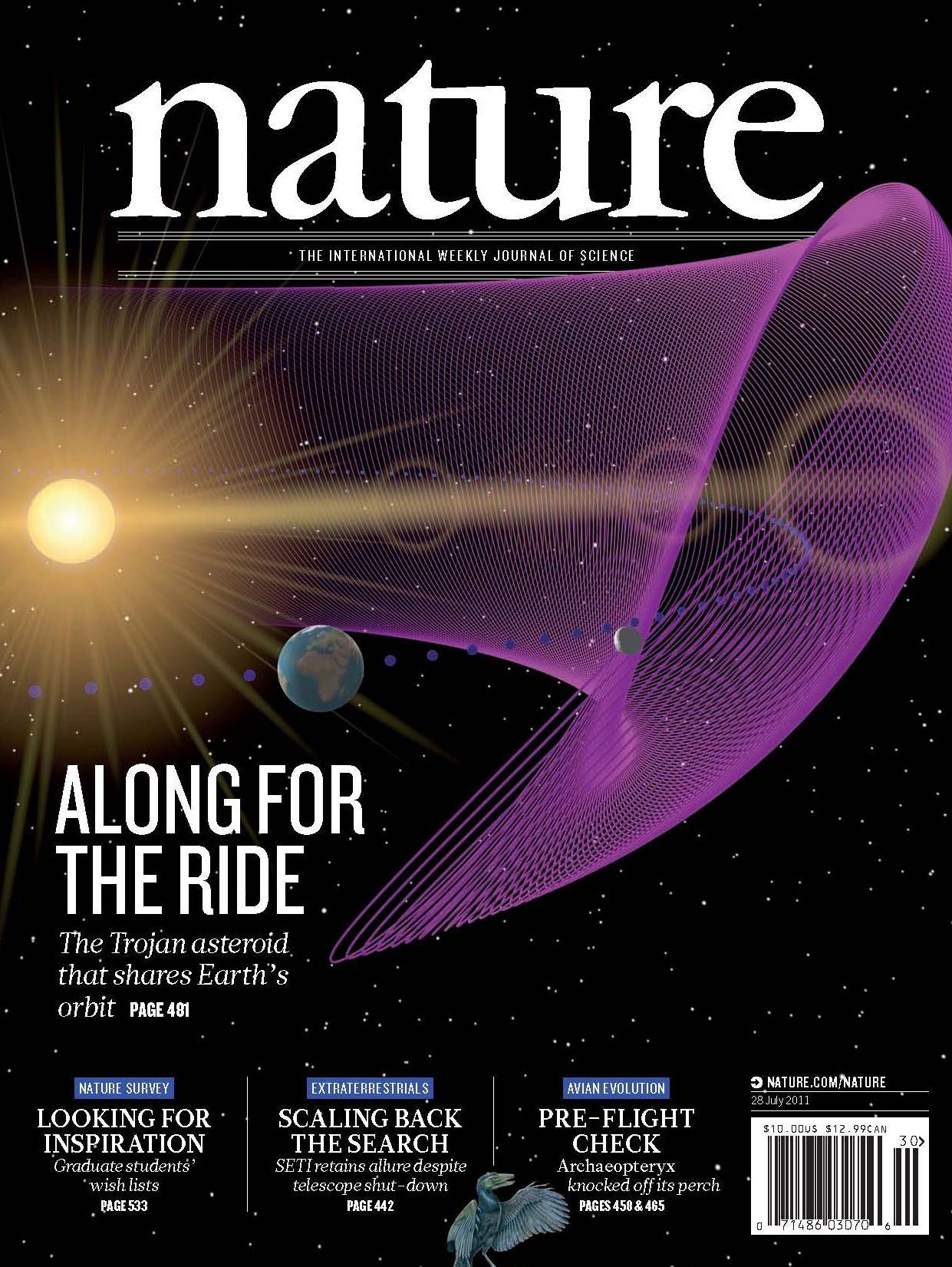NASA JPL-Caltech | NEOWISE Mission | 2011 July 27
Astronomers studying observations taken by NASA's Wide-field Infrared Survey Explorer (WISE) mission have discovered the first known "Trojan" asteroid orbiting the sun along with Earth.Click to play embedded YouTube video.
Trojans are asteroids that share an orbit with a planet near stable points in front of or behind the planet. Because they constantly lead or follow in the same orbit as the planet, they never can collide with it. In our solar system, Trojans also share orbits with Neptune, Mars and Jupiter. Two of Saturn's moons share orbits with Trojans.
Scientists had predicted Earth should have Trojans, but they have been difficult to find because they are relatively small and appear near the sun from Earth's point of view.
"These asteroids dwell mostly in the daylight, making them very hard to see," said Martin Connors of Athabasca University in Canada, lead author of a new paper on the discovery in the July 28 issue of the journal Nature. "But we finally found one, because the object has an unusual orbit that takes it farther away from the sun than what is typical for Trojans. WISE was a game-changer, giving us a point of view difficult to have at Earth's surface."
The WISE telescope scanned the entire sky in infrared light from January 2010 to February 2011. Connors and his team began their search for an Earth Trojan using data from NEOWISE, an addition to the WISE mission that focused in part on near-Earth objects, or NEOs, such as asteroids and comets. NEOs are bodies that pass within 28 million miles (45 million kilometers) of Earth's path around the sun. The NEOWISE project observed more than 155,000 asteroids in the main belt between Mars and Jupiter, and more than 500 NEOs, discovering 132 that were previously unknown.
The team's hunt resulted in two Trojan candidates. One called 2010 TK7 was confirmed as an Earth Trojan after follow-up observations with the Canada-France-Hawaii Telescope on Mauna Kea in Hawaii.
The asteroid is roughly 1,000 feet (300 meters) in diameter. It has an unusual orbit that traces a complex motion near a stable point in the plane of Earth's orbit, although the asteroid also moves above and below the plane. The object is about 50 million miles (80 million kilometers) from Earth. The asteroid's orbit is well-defined and for at least the next 100 years, it will not come closer to Earth than 15 million miles (24 million kilometers). An animation showing the orbit is available.
"It's as though Earth is playing follow the leader," said Amy Mainzer, the principal investigator of NEOWISE at NASA's Jet Propulsion Laboratory in Pasadena, Calif. "Earth always is chasing this asteroid around."
A handful of other asteroids also have orbits similar to Earth. Such objects could make excellent candidates for future robotic or human exploration. Asteroid 2010 TK7 is not a good target because it travels too far above and below the plane of Earth's orbit, which would require large amounts of fuel to reach it.
"This observation illustrates why NASA's NEO Observation program funded the mission enhancement to process data collected by WISE," said Lindley Johnson, NEOWISE program executive at NASA Headquarters in Washington. "We believed there was great potential to find objects in near-Earth space that had not been seen before."
http://www.nasa.gov/wise
http://wise.ssl.berkeley.edu/
Earth's Little Buddy
ScienceShot | Sid Perkins | 2011 July 27
Earth’s Trojan Asteroid - Martin Connors, Paul Wiegert, Christian VeilletEarth has a new sidekick. Astronomers have spotted a small asteroid traveling around our sun in the same general path as our planet. The 300-meter-wide rock, dubbed 2010 TK7, is Earth's first so-called "Trojan" asteroid, a class of bodies that gets its name from the asteroids that orbit the sun at the gravitationally stable points 60° ahead of and 60° behind Jupiter—which, according to astronomical convention, are individually named after prominent figures from the Trojan War (Brad Pitt excepted). Besides the thousands of Trojans that co-orbit the sun with Jupiter, astronomers have discovered a handful that co-orbit the sun with Neptune and Mars. 2010 TK7 isn't a threat to Earth. For one thing it's ahead of us, not behind us. And its current orbit brings it no closer than 20 million kilometers or so once every 395 years. Call it a partner for life, or at least for the next 5000 years, the period for which astronomers can reliably predict its chaotic orbit.
- Nature 475 481 (28 July 2011) DOI: 10.1038/nature10233 (pdf)
CFHT | Paul Wiegert | 2011 July 27
Astronomers find Earth's first trojan asteroid
ars technica | Adam Stevenson | 2011 July 27
Earth stalker found in eternal twilight
New Scientist | Michael Reilly | 2011 July 27
First Asteroid Companion of Earth Discovered at Last
Space.com | Charles Q Choi | 2011 July 27
WISE finds the very first Earth Trojan asteroid
Discover Blogs | Bad Astronomy | 2011 July 27
Earth’s First Trojan Asteroid Discovered
Universe Today | Nancy Atkinson | 2011 July 27
Study: Earth shares its orbit with tiny asteroid
PhysOrg | Malcolm Ritter, AP | 2011 July 27
Earth's Traveling Companion
Sky & Telescope | Kelly Beatty | 2011 July 27
New meteor shower points to a future close encounter
Discover Blogs | Bad Astronomy | 2011 July 28
A Trojan Asteroid for Earth
Centauri Dreams | Paul Gilster | 2011 July 29


